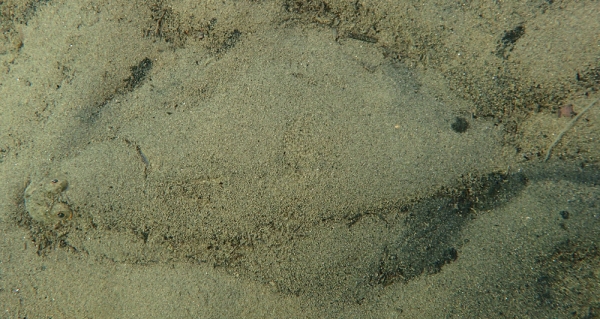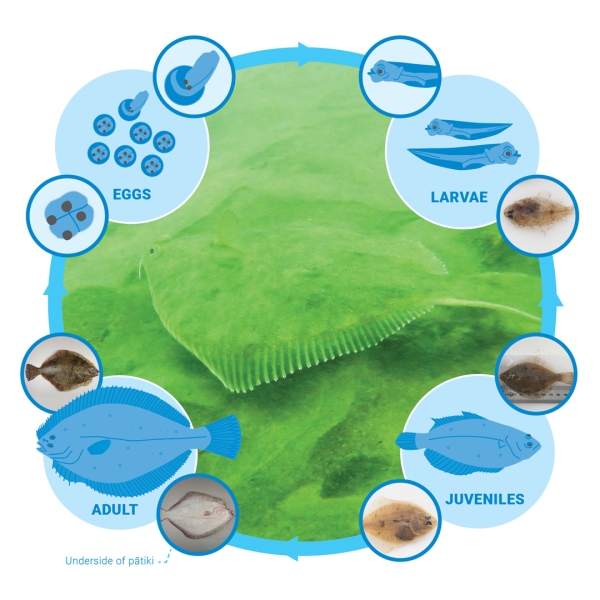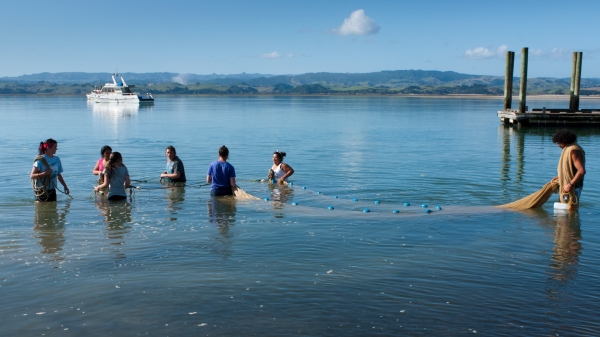Taonga species such as tuna (freshwater eel), kōura (freshwater crayfish) and kākahi (freshwater mussels) are central to the identity and wellbeing of many Māori.
For generations these species have sustained communities and helped transfer customary practices and knowledge from one generation to the next.
However, many communities are reporting that both the abundance and size of these freshwater taonga are declining. Te Kūwaha, NIWA’s National Centre for Māori Environmental Research has been working with whānau, hapū and iwi for more than a decade to co-develop methods for the protection, restoration and economic development of these species.
Pātiki species
There are four key species of pātiki commonly foundaround the shores of Aotearoa.
Rhombosolea plebeia
- Common name: Sand flounder
- Māori name: Pātiki
Identify by:
- Diamond shape
- Greenish brown withwhite belly
- Maximum length 45 cm
Rhombosolea retiaria
- Common name: Black flounder
- Māori name: Pātiki-mohoao
Identify by:
- Oval shape
- Brick orange spots onblack back
- Maximum length 45 cm
Rhombosolea leporina
- Common name: Yellow-belly flounder
- Māori name: Pātiki-tōtara
Identify by:
- Oval shape
- Greenish brown with yellow belly
- Maximum length 50 cm
Rhombosolea tapirina
- Common name: Greenback flounder
Identify by:
- Oval shape
- Dark green with white belly
- Maximum length 50cm
Where do Pātiki live?
Pātiki are found in shallow, brackish (slightly salty) waters including harbours, estuaries and inlets, coastal lakes and even rivers.
Sand, yellow-belly and greenback flounder choose places to live where they can hide in plain sight. They like muddy and sandy bottoms where they can bury themselves just below the surface and camouflage themselves. These three species tend to live in shallow water when they are young and move into deeper water as adults.
You can find yellow-belly flounder in shallow, muddy areas, whereas, sand flounder (as their name suggests) tend to prefer sandier habitats in harbours and open coastlines. Yellowbelly and sand flounder can also be found on surf beaches around Aotearoa.
Black flounder like estuaries, harbours, inlets and coastal lakes but can also be found in both freshwater rivers as well as the open coastline. They are the only species that can live in completely fresh water.
Pātiki camouflage
Pātiki can rapidly change their colour to better blend into their environment. This helps them to hide and wait for their prey to pass.
Life Cycle
Pātiki are unusual in that they start their lives similar to most fish as eggs and swimming larvae, before transforming their bodies to allow them to swim and lie flat on the bottom of the sea.
-
Eggs
The pātiki starts its life as an egg off the coast. They spawn offshore and are washed into the estuaries with tides. Some pātiki can produce up to one million eggs each spawning event.
-
Larvae
Pātiki hatch into an upright swimming fish with one eye on each side of their body. As they grow the left eye moves to the right side of the head to prepare for when they are lying on the seafloor. Although they can swim a little, they are usually carried by the currents and tides into estuaries, harbours and inlets.
-
Juvenile pātiki
Once the eyes of the pātiki are both on the right side of their bodies, they begin to lie on their sides and move to the seafloor as juveniles. As juveniles, they like to stay in the shallower parts of estuaries, harbours and inlets.
-
Adult pātiki
After about two years, pātiki have grown enough to begin to move out into deeper waters including the deeper parts of estuaries and harbours and inlets as well as out onto the open coastline. Sand flounder males reach maturity at around 12 cm, females from 18 – 22 cm. Yellow-belly flounder males mature at 15 cm and females at 26 – 27 cm. During summers they travel back into harbours to feed and to prepare to spawn in late winter and spring.
What do pātiki eat?
Pātiki like to eat anything they find on the seafloor. They ambush their prey and gulp it when they see it. If they eat any seaweed it is usually by accident.
When the pātiki are living in the estuary or sea close to the coast they like to eat crabs, shellfish, brittle stars, polychaete worms and anemones. All the pātiki hide in the sand or mud and wait till their prey comes past, then quickly gulp and swallow their food.
Because they ambush their prey and gulp it up they often eat a little bit of mud, sand and seaweed at the same time.
Yellow-belly and black flounder eat freshwater insects like midges and dobson-fly larvae if they are living in a freshwater environment.
How to tell how old a pātiki is
It is not possible to tell the age of a pātiki just by looking at its size. Pātiki size depends on location, how much kai is available and whether it is male or female.
The only way to age a pātiki is by looking at the ear bones (called otoliths). The otoliths grow as pātiki grow and each year a new layer is added like tree rings – to age the pātiki you count the rings.
Removing otoliths from pātiki can be difficult and reading them even more so as they are so small.
The oldest known pātiki in Aotearoa was a 10-year-old greenback flounder, found off the southeast coast of the South Island.
How big do pātiki grow?
Most of our pātiki species grow up to 45 – 50 cm long. Females can grow larger than males (like the sand and yellow-belly females). The same species can grow larger in the South Island than in the North Island. For example, the sand flounder grows up to 30 cm in the North Island and up to 40 cm in the South Island.
Maturity
Sand flounder males reach maturity at around 12 cm, but females mature from 18 – 22 cm depending on where they come from. Yellow-belly flounder need to be a little larger, with males maturing at 15 cm and females maturing at 26 – 27 cm. There is currently no information about how long our black or greenback flounder are before they mature.
Pātiki fishery
All four pātiki species are commercially fished across New Zealand alongside four other flatfish species.
The commercial and recreational fisheries are subject to minimum size limits of 23cm for sand flounder, and 25cm for yellow-belly, black and greenback flounder.
There are regional differences in the way you can catch pātiki, as well as how many you can take.
All pātiki species have been managed as one fishery under the code FLA but in recent times fishers have started to use individual species codes to help us better understand the differences in each of these pātiki catches.
What are the pressures on pātiki?
- The amount of oxygen, temperature, nutrients and sedimentation in the water can harm young pātiki population numbers. Climate change and continued degradation of estuarine environments may intensify these impacts.
- Invasive species have the potential to impact our pātiki and their habitats through competition, predation and habitat modification.
- Continued fishing pressure from both commercial and recreational fishers is also impacting our pātiki.
How can we help pātiki?
Some ways we can help our pātiki populations include:
- Monitor the numbers of your local juvenile pātiki
- Protect and restore pātiki habitat
- Ensure that enough adults reach sexual maturity
- Keep an eye out for invasive species like the Asian paddle crab which may eat juvenile pātiki
- Support the improvement of water quality flowing into estuaries, harbours and inlets e.g. riparian planting beside streams.
Download
- Pātiki: What does science tell us about New Zealand flounder? (PDF 2 MB)
- Pātiki lifecycle poster (PDF 1.67 MB)





